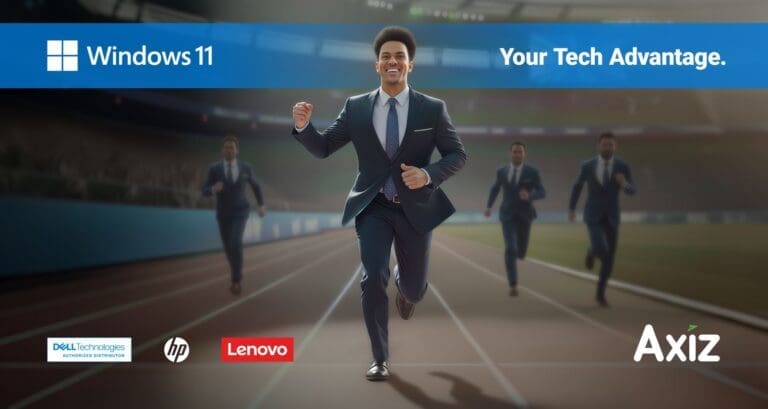2025 is being called the year of the ‘Windows 11 Refresh’, and the opportunity to stay ahead of the pack is quickly narrowing. The shift to Windows 11 is happening now: the new generation of Windows 11 PCs are often referred to as the most secure, the fastest, and the most intelligent PCs yet – arriving with AI-powered features, built-in security protections and state-of-the-art creativity, it’s the Windows you know, and more. Whether your company has already rolled out the operating system or is still finalising procurement, the critical question is no longer when you will move, but how quickly can your business turn this upgrade into a competitive advantage.
A recent study published on Windows Central indicates that almost half of all PCs have not yet upgraded to Windows 11, with enterprise devices in finance, healthcare, and government sectors particularly behind. Outdated hardware slows performance, increases maintenance costs, and leaves companies exposed to cyber threats. The next few months are crucial – companies that delay their upgrade risk running devices that no longer receive security updates, experience poor performance and ultimately hinder operations. The study also highlights that a significant portion of current devices will need to be completely replaced to fully leverage Windows 11, and planning a coordinated device refresh is essential to avoiding supplier shortages, reducing ongoing costs, and enabling employees to use the latest tools without disrupting business operations.
Why migration matters
Migration to Windows 11 is about more than simply staying current. According to industry guidance, every organisation that delays faces a growing gap in performance, security, and compliance. For nearly a decade, Windows 10 was the world’s most popular operating system, until Windows 11 surpassed its traffic earlier this year. Ten years is a relatively standard time span for OS support, but this end-of-life scenario is particularly unique, given how many PCs will not meet Microsoft’s minimum requirements for an upgrade. Microsoft’s planned end-of-support for Windows 10 means that older machines will no longer receive critical patches, leaving systems vulnerable to increasingly sophisticated cyber threats. Moving early allows IT teams to schedule upgrades strategically, avoid last-minute supply issues, and take advantage of modern management tools that simplify deployment across a hybrid workforce.
Beyond risk management, migration unlocks immediate operational gains. Windows 11 is designed for the realities of a future work environment which includes AI-driven software which requires faster boot times, improved power efficiency, and seamless integration with cloud services.
Early adopters of Windows 11 have reported smoother remote collaboration and more stable performance, enabling staff to stay productive wherever they work.
What can businesses expect with the upgrade to Windows 11
- Advanced security and compliance
Hardware-Backed Security: Windows 11 requires a TPM 2.0 chip and incorporates features like Secure Boot and Windows Hello for enhanced data protection and user authentication.
Zero-Trust Security Model: The operating system is designed around a zero-trust security approach, offering multiple layers of hardware-backed protection against evolving cyber threats and unauthorised access.
- Enhanced productivity and collaboration
Modern multitasking: Features like Snap Layouts allow users to organise open windows into structured groups while virtual desktops enable the separation of workspaces, helping employees to focus and work more efficiently.
Seamless Microsoft 365 integration: Deeper integration with other Microsoft services like OneDrive and Outlook simplifies file sharing and collaboration.
- Streamlined IT and device management
Cloud-based management: IT administrators can manage devices, security configurations, and applications from a unified, central console using cloud-based tools.
Simplified deployment: Windows 11 is designed for straightforward, cost-effective deployment, featuring automated updates and granular control over applications and data.
- Improved performance and user experience
Faster performance: Optimised resource management and faster load times result in better device performance, smoother multitasking, and quicker access to files and applications.
Android App support: For the first time, users can run Android apps on their desktops, expanding the functionality within the Windows environment.
Companies that act now can not only safeguard their systems and streamline operations but also position themselves to leverage AI, cloud integration, and modern security features ahead of their competitors. In a landscape where efficiency, resilience, and innovation define success, the question isn’t whether to upgrade – it’s how quickly your organisation can turn this transition into a tangible advantage.
The end of Windows 10 support could be a springboard for growth. By planning your Windows 11 migration now, you can avoid last-minute supply pressures, strengthen security, and unlock the AI-driven features and cloud integrations your teams need to stay competitive. Axiz—the leading IT distributor across Southern Africa—can help you choose the right Windows 11 solutions and secure devices from trusted brands such as Dell, HP, and Lenovo, ensuring a smooth transition and sustained productivity.
Find out more at https://axizcloud.com/.
Ends//

